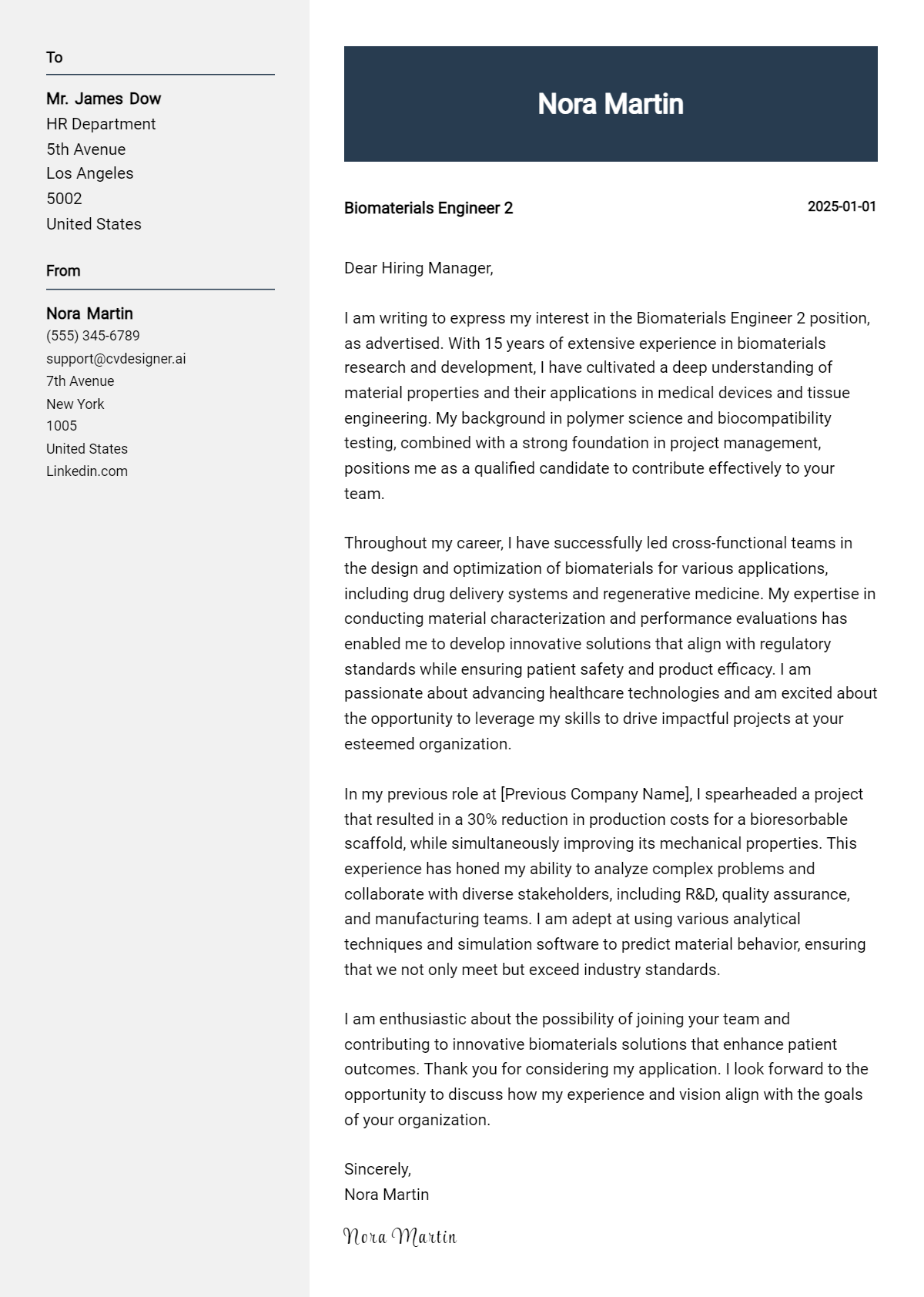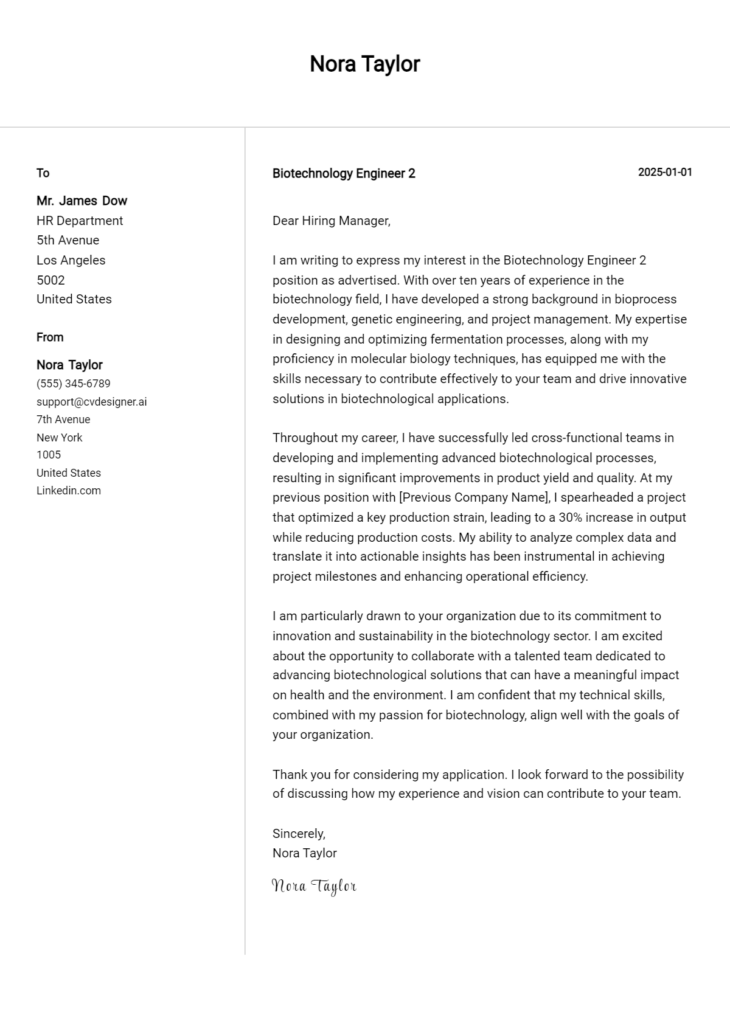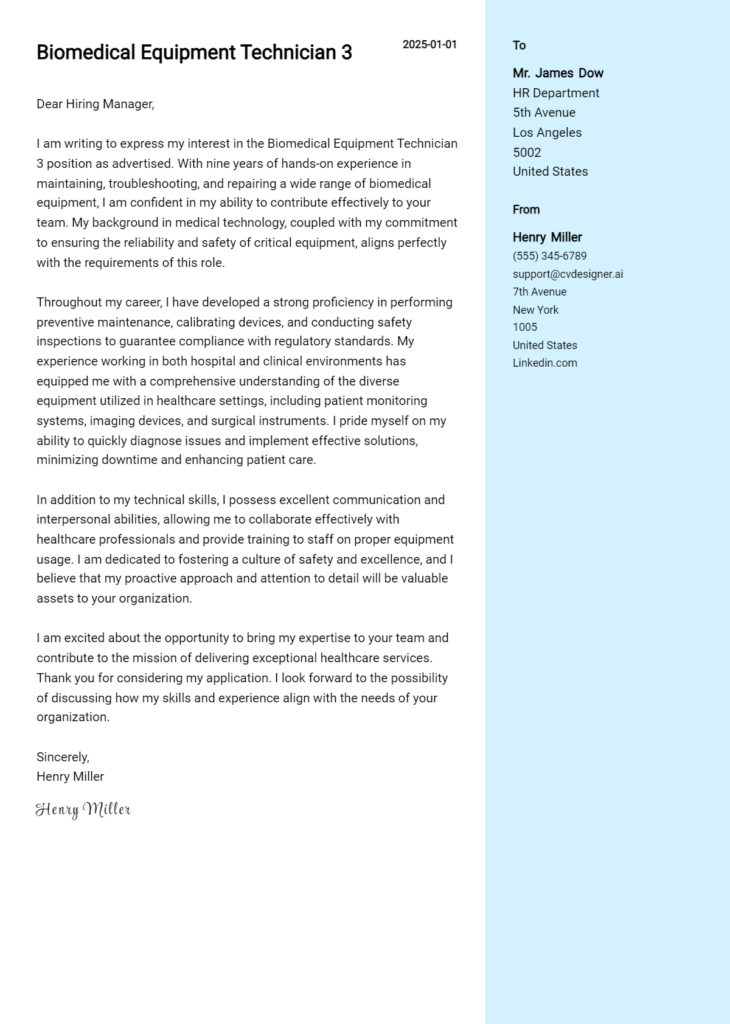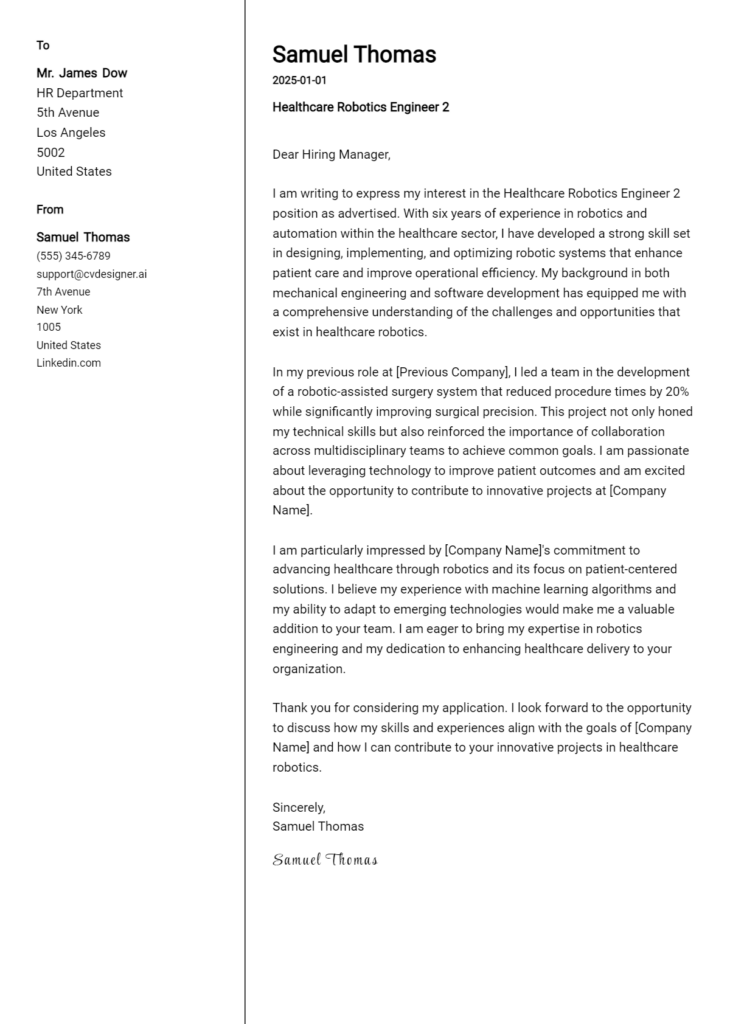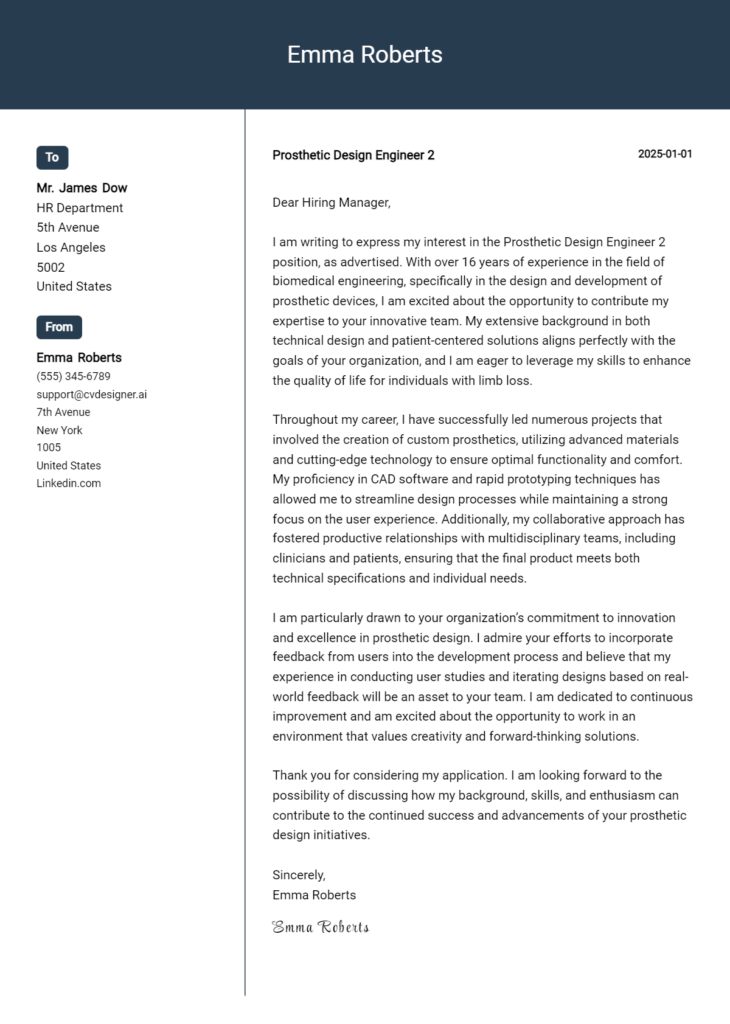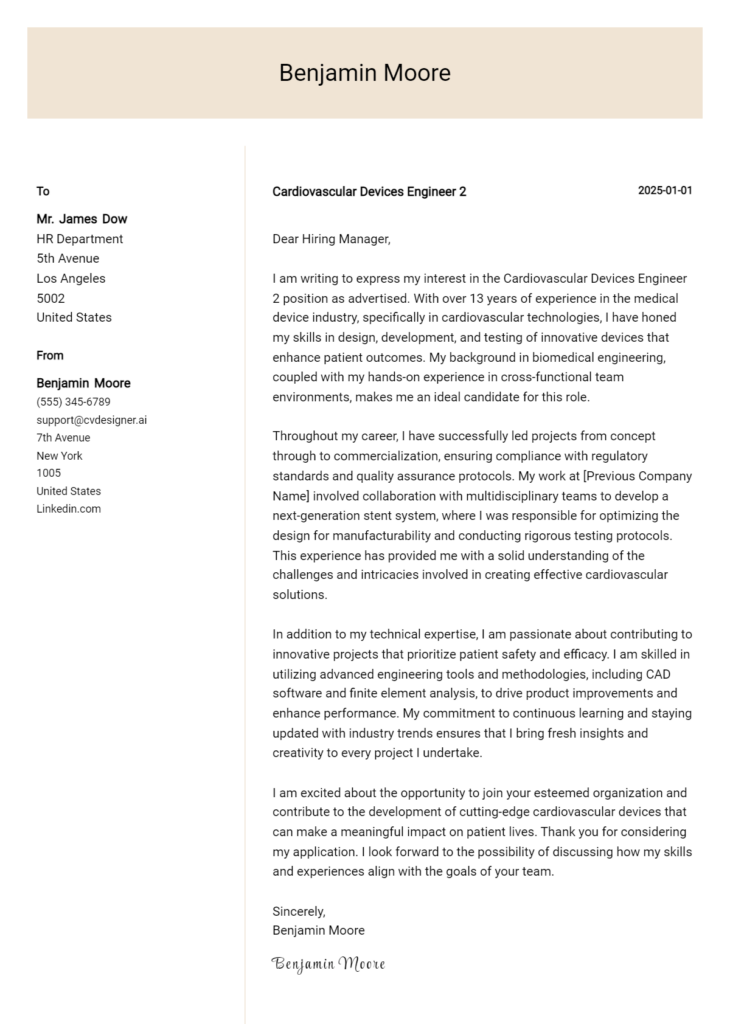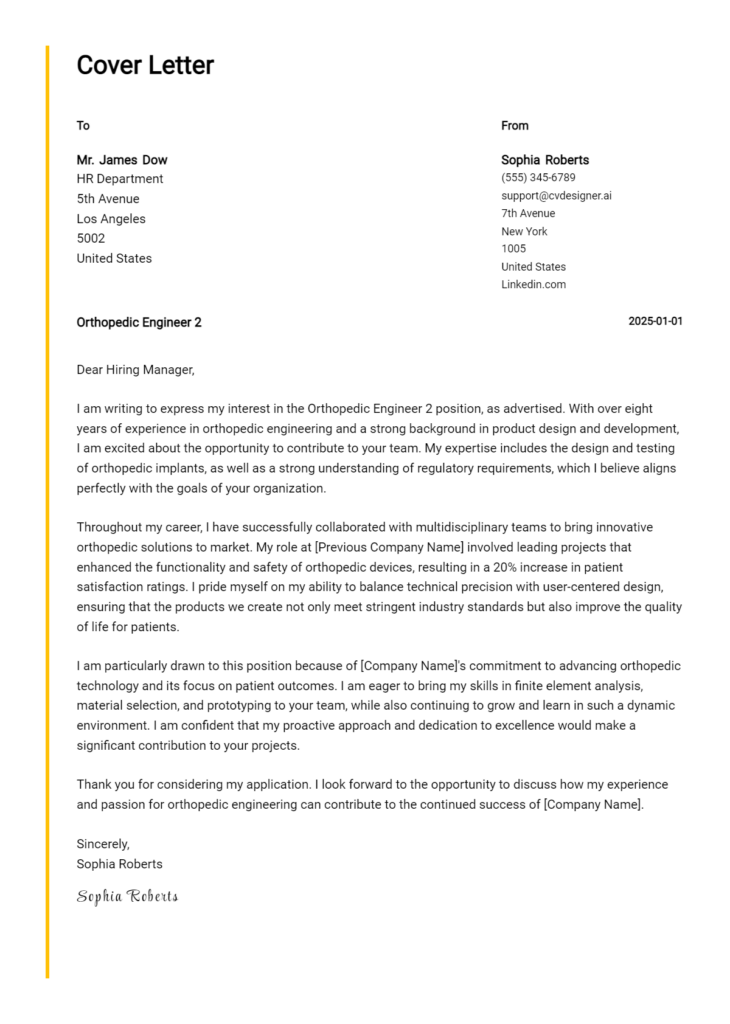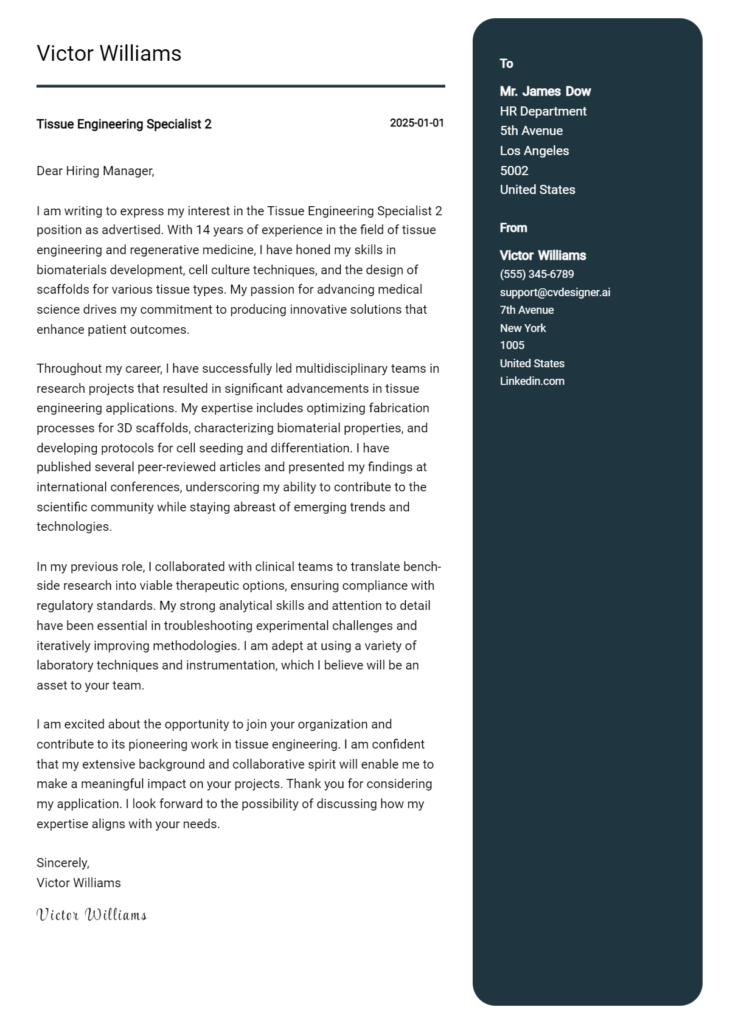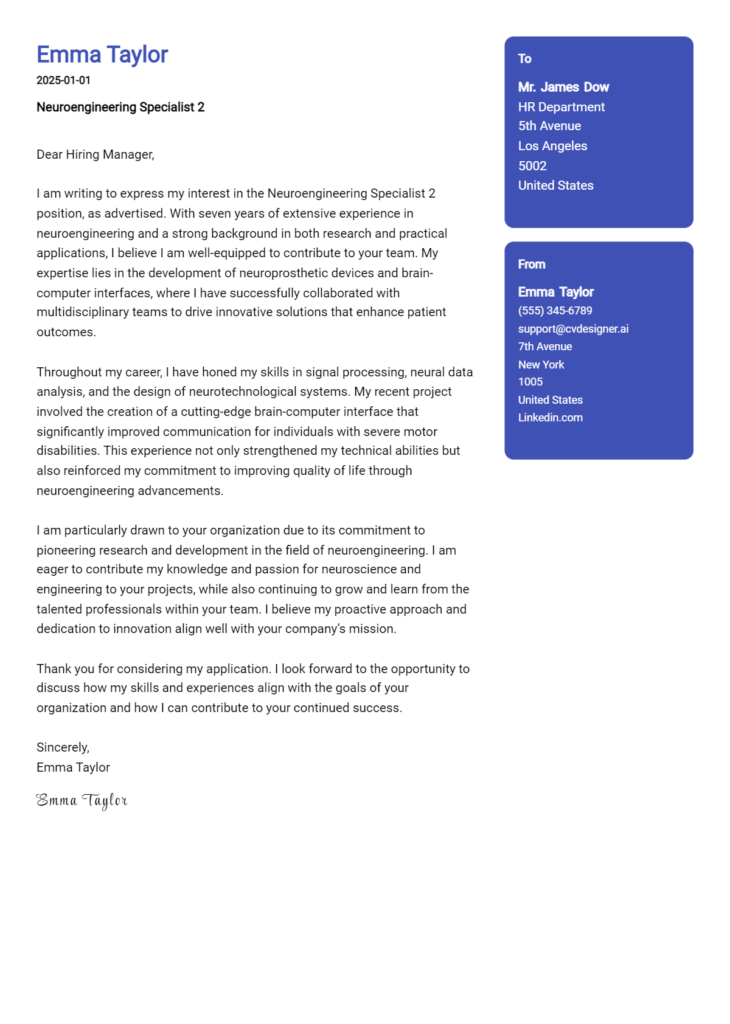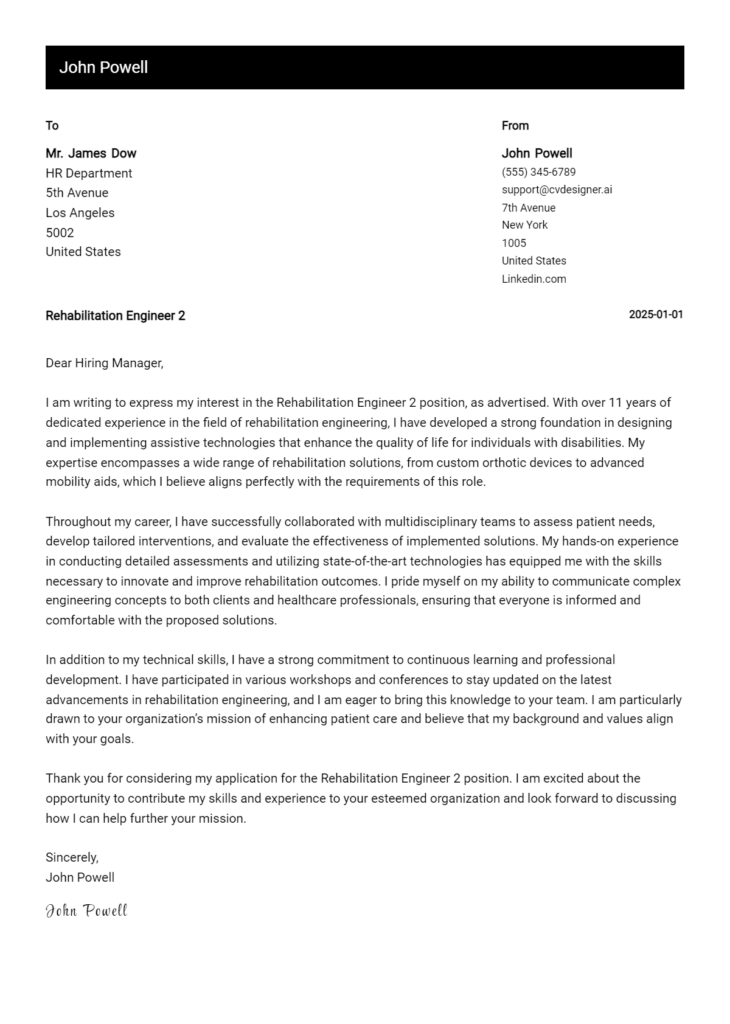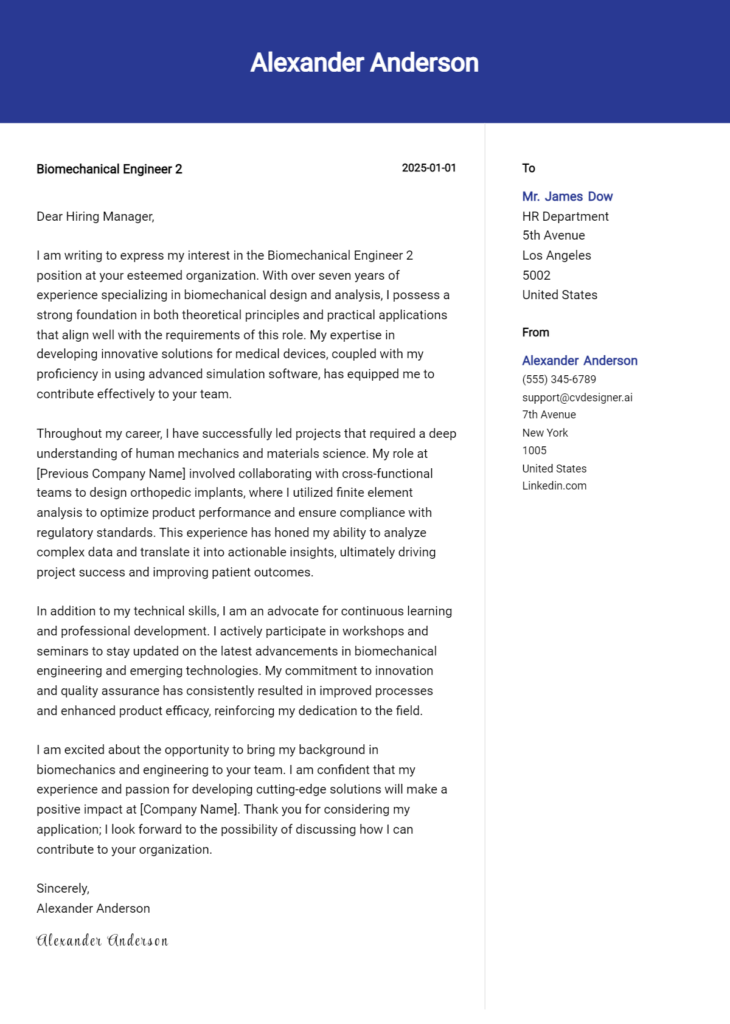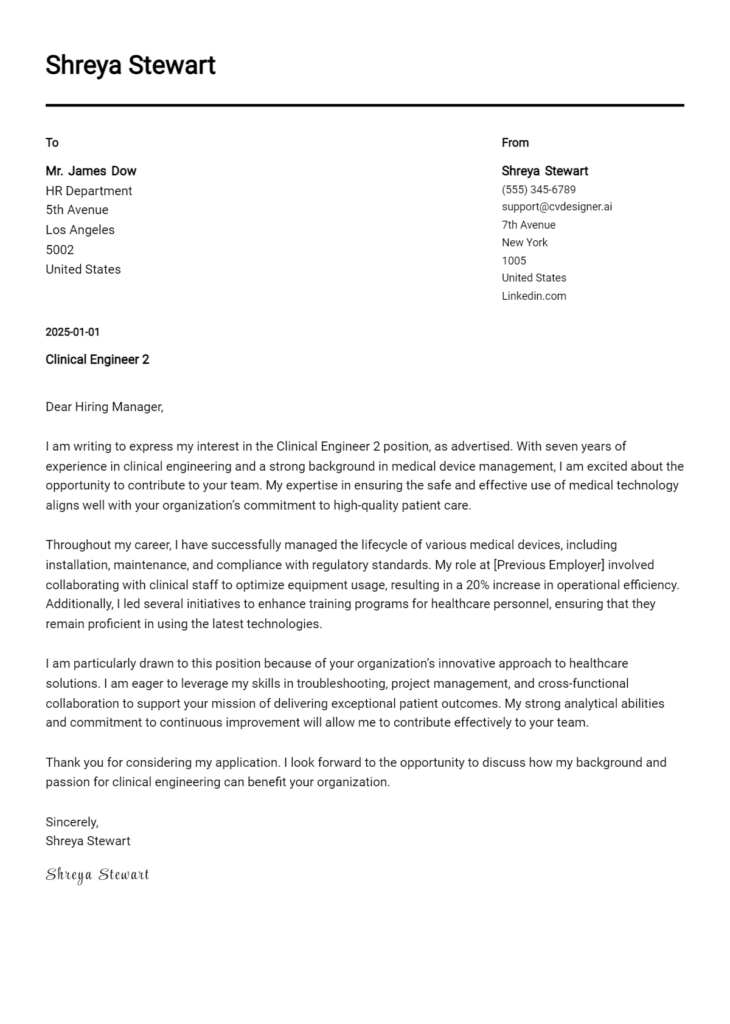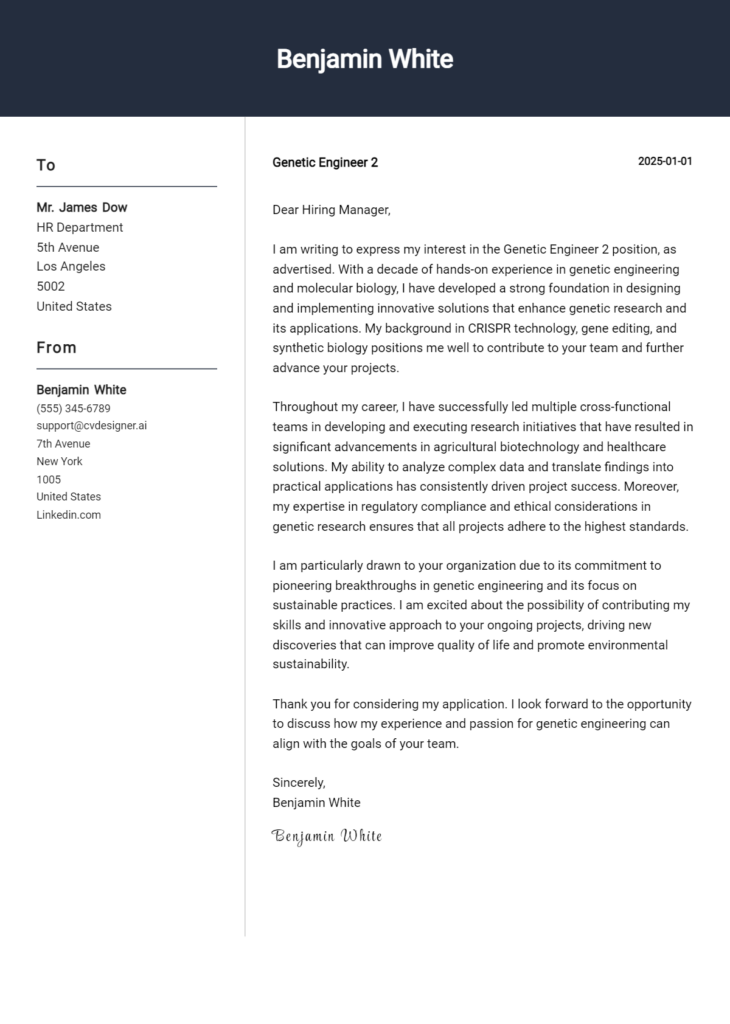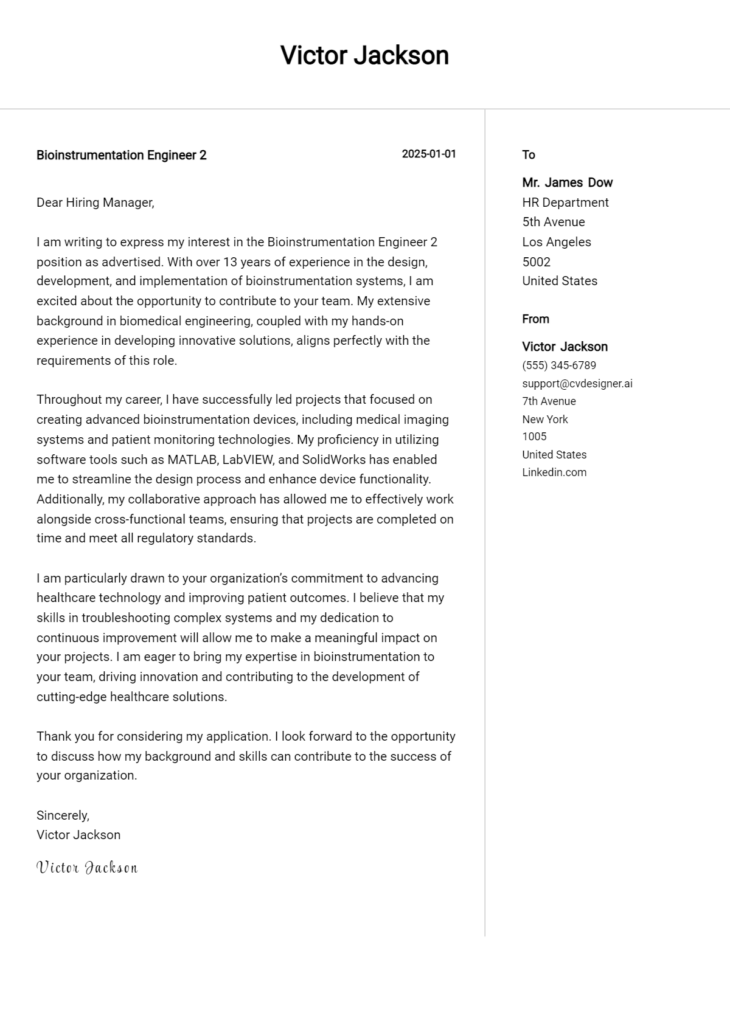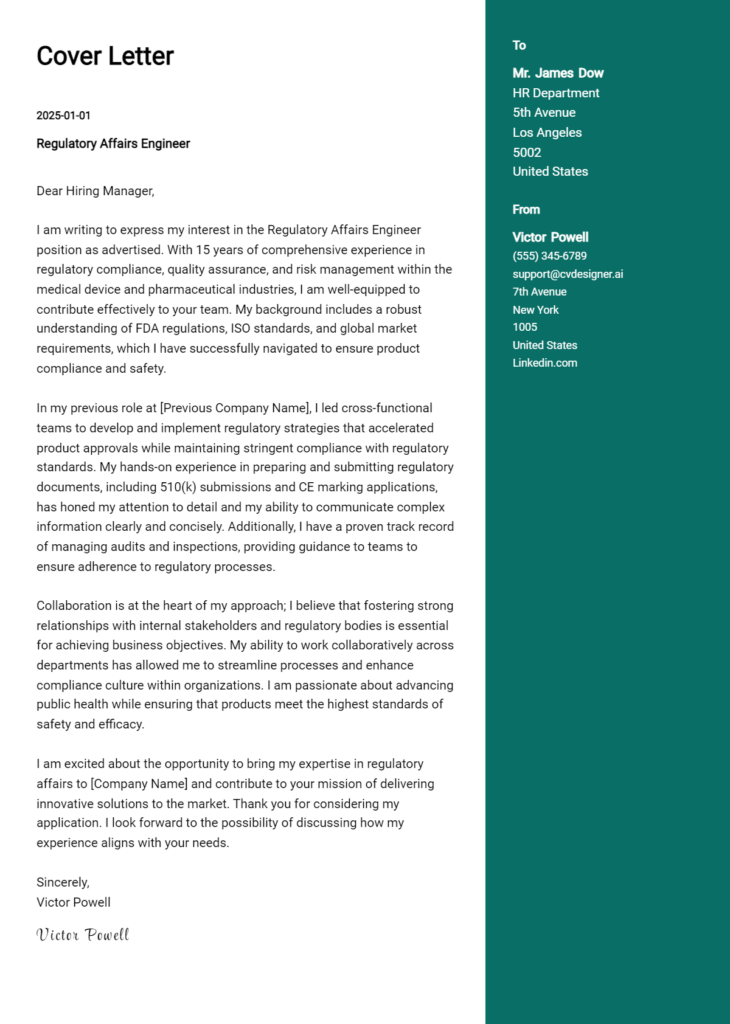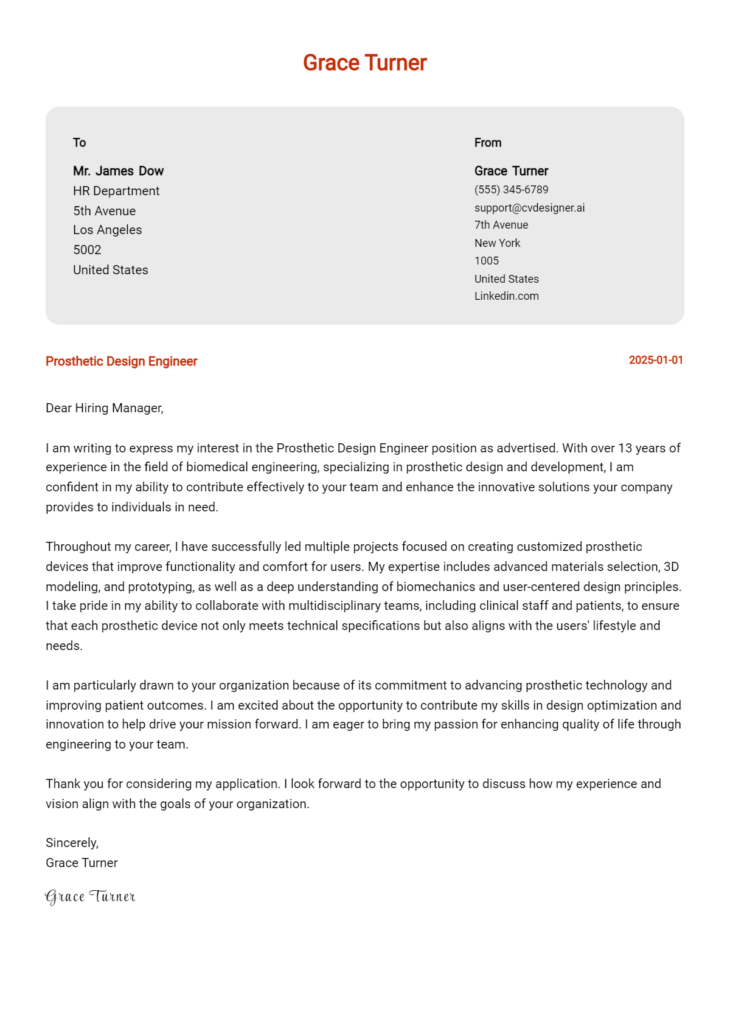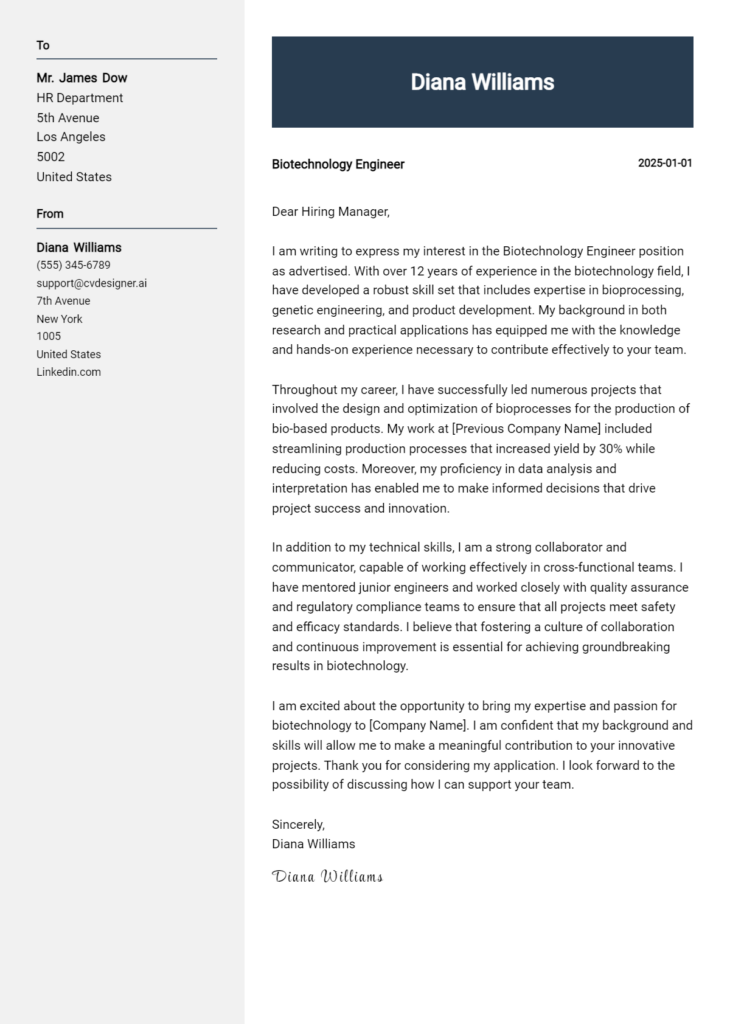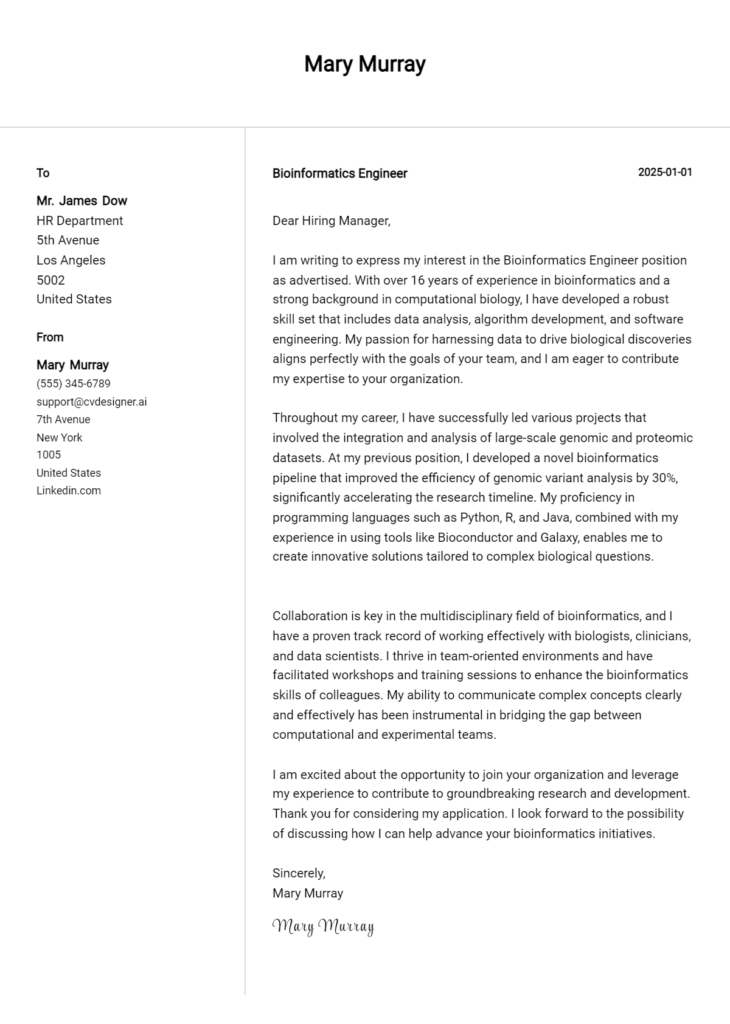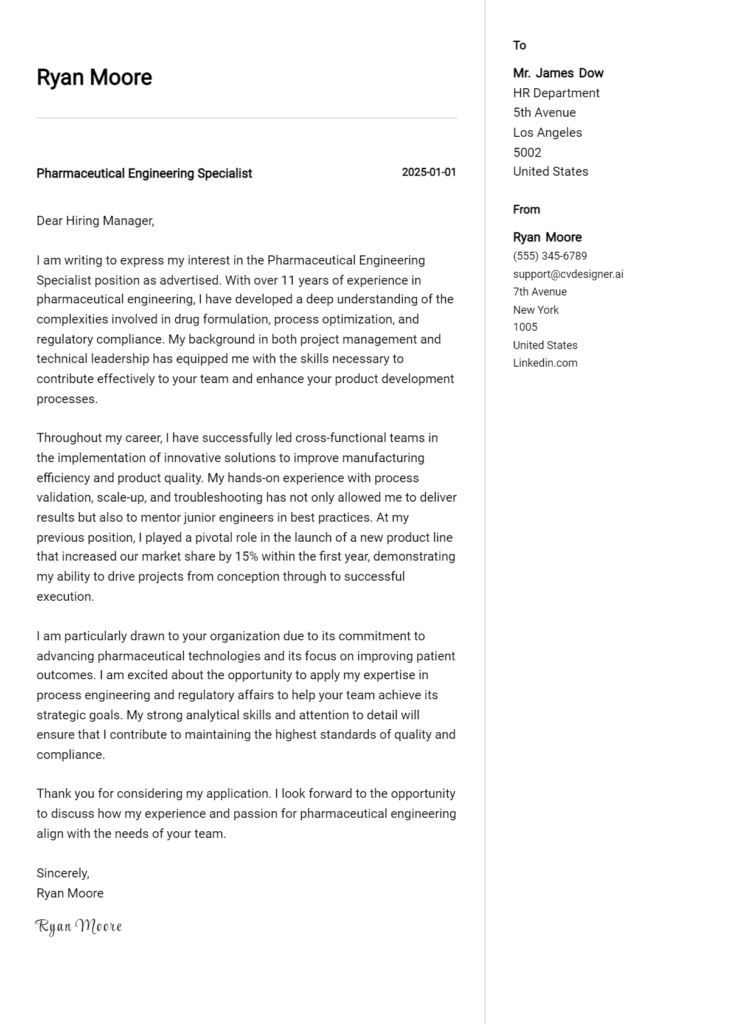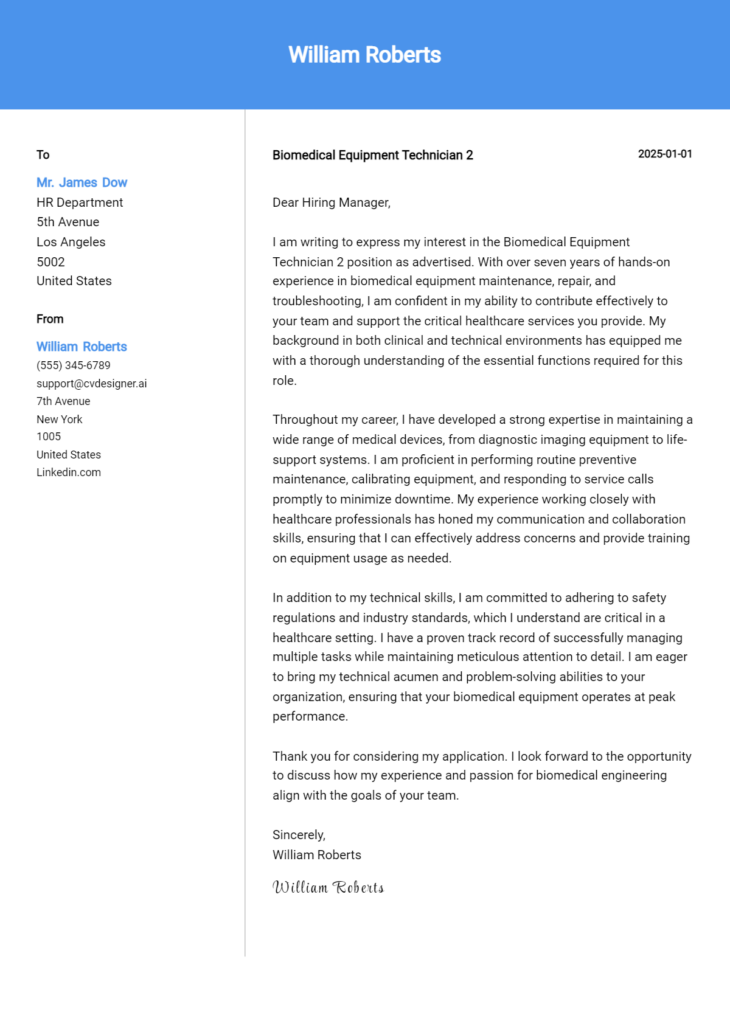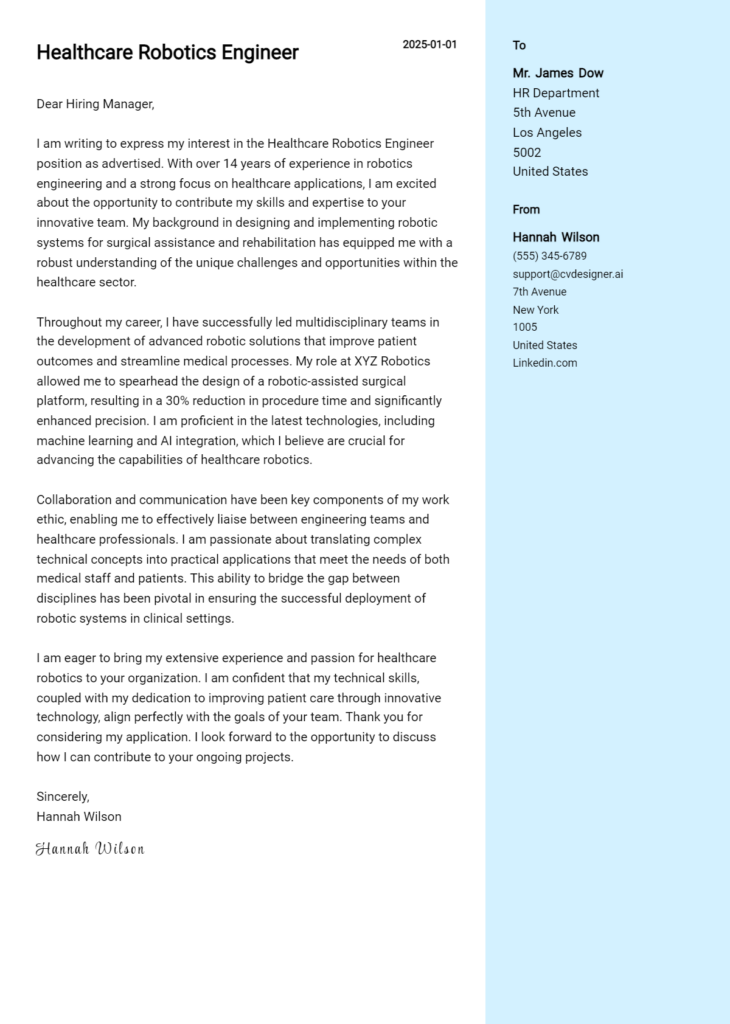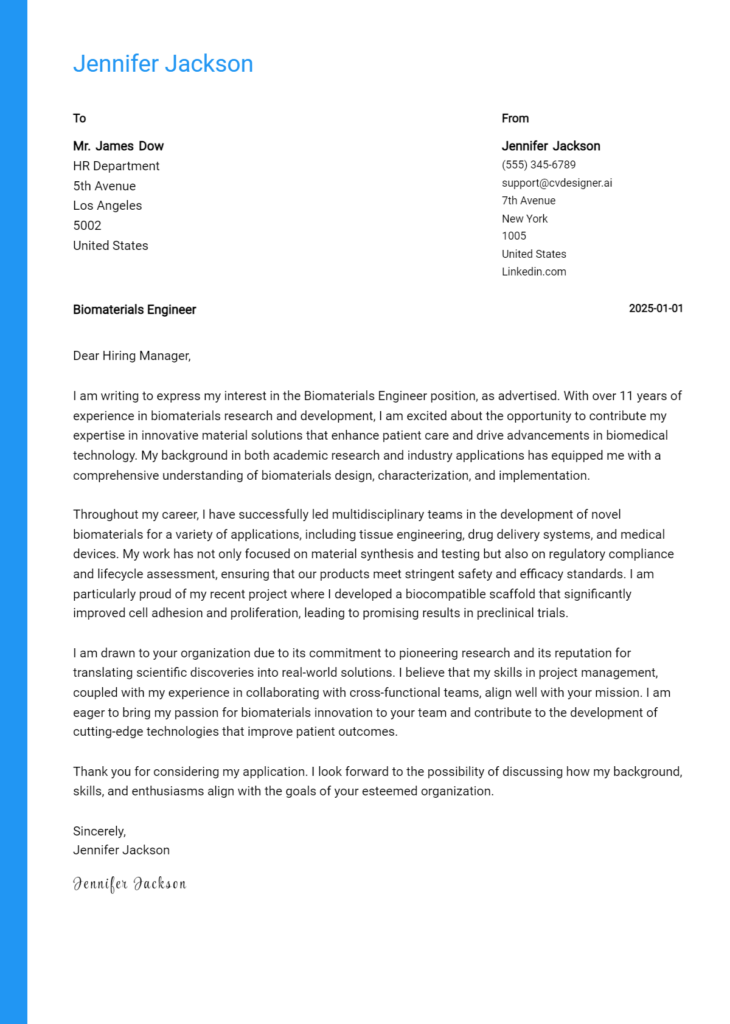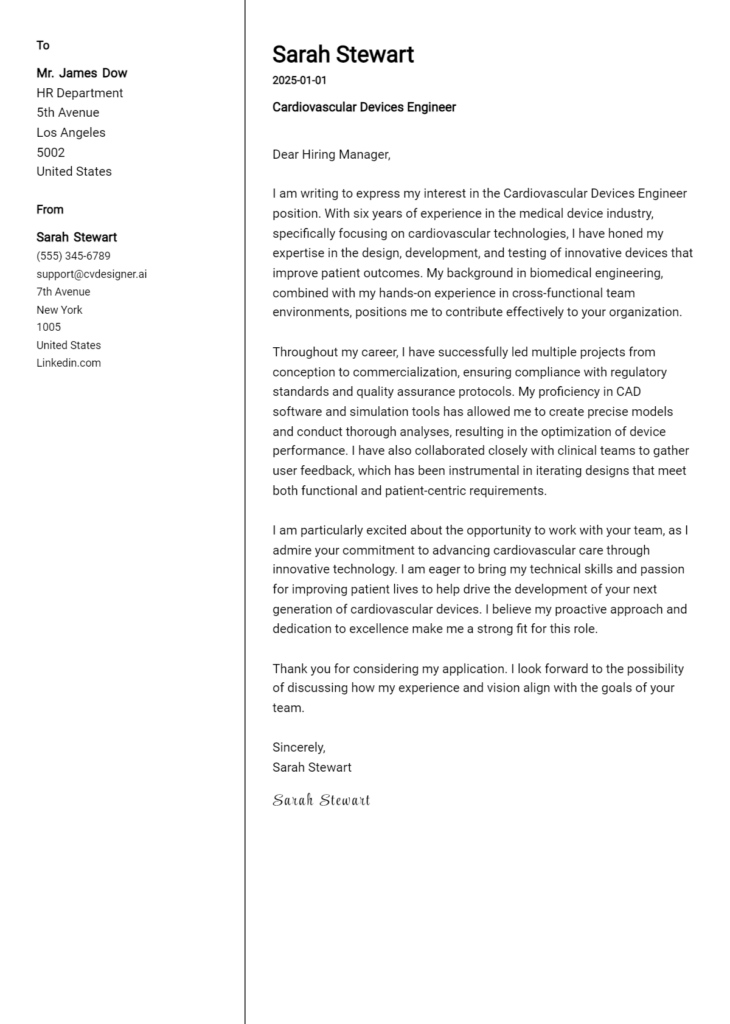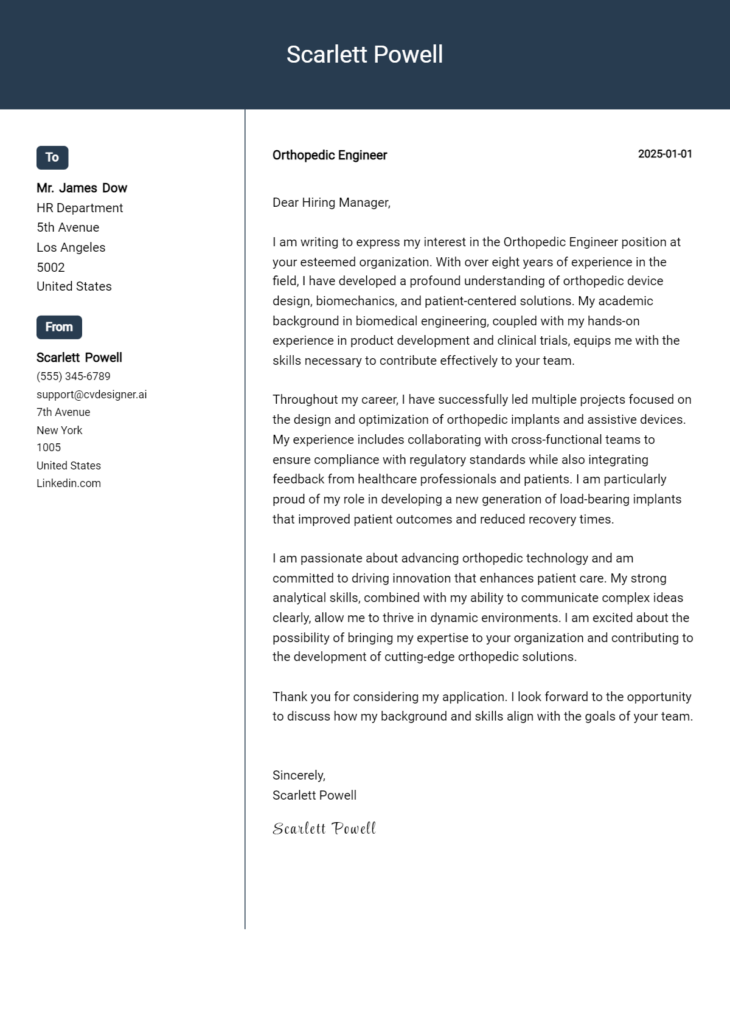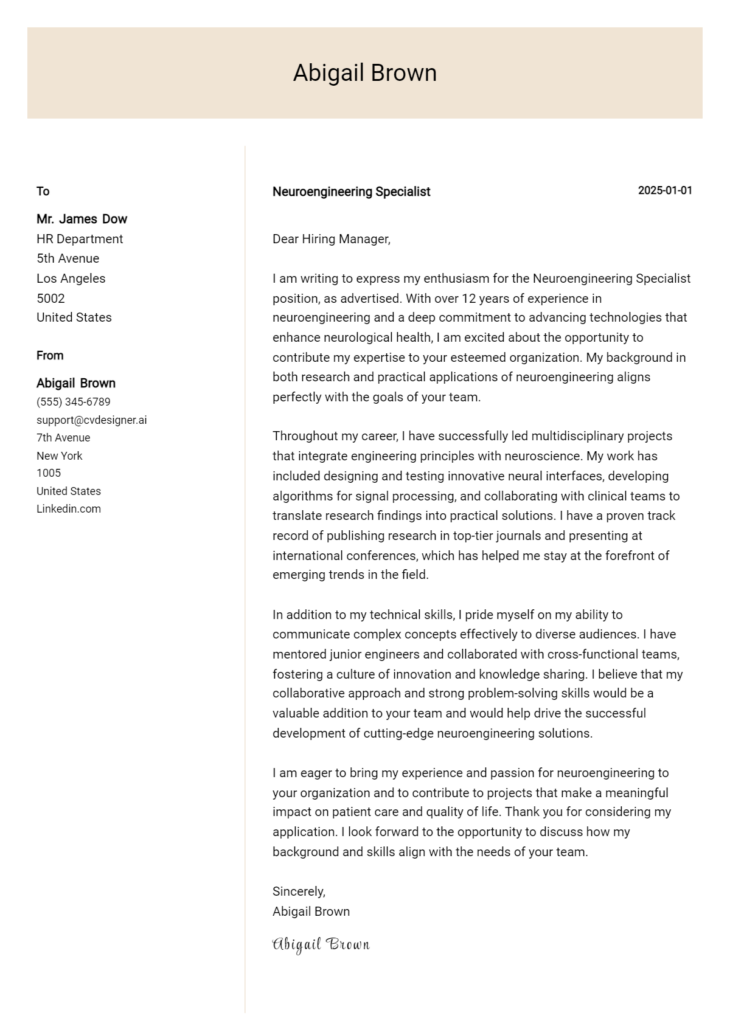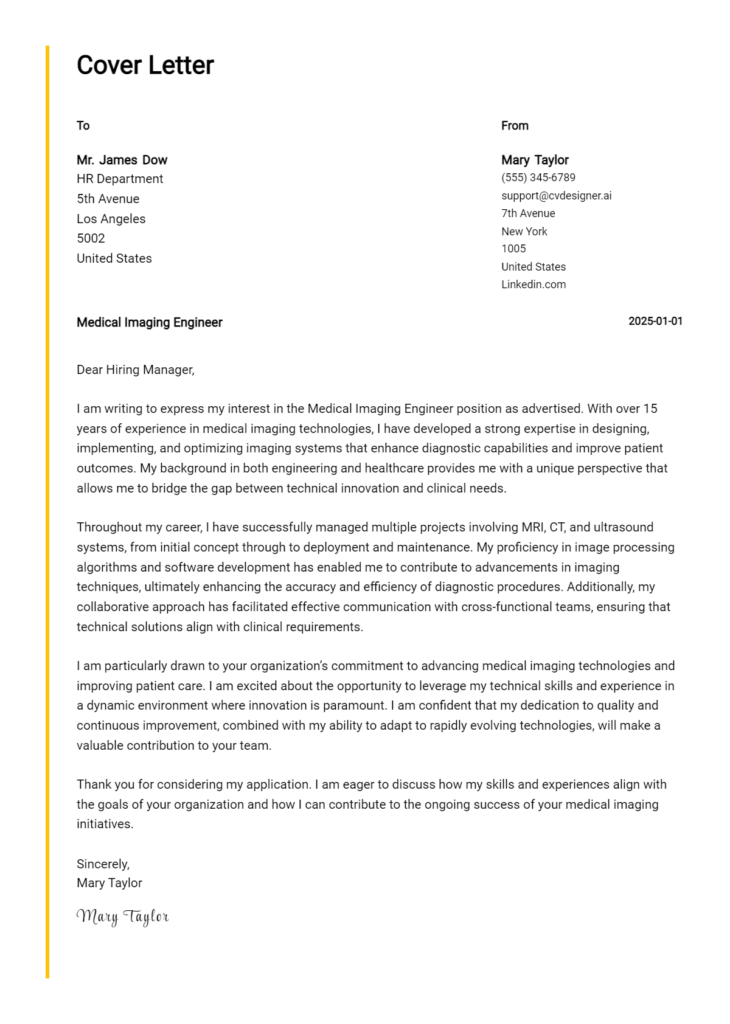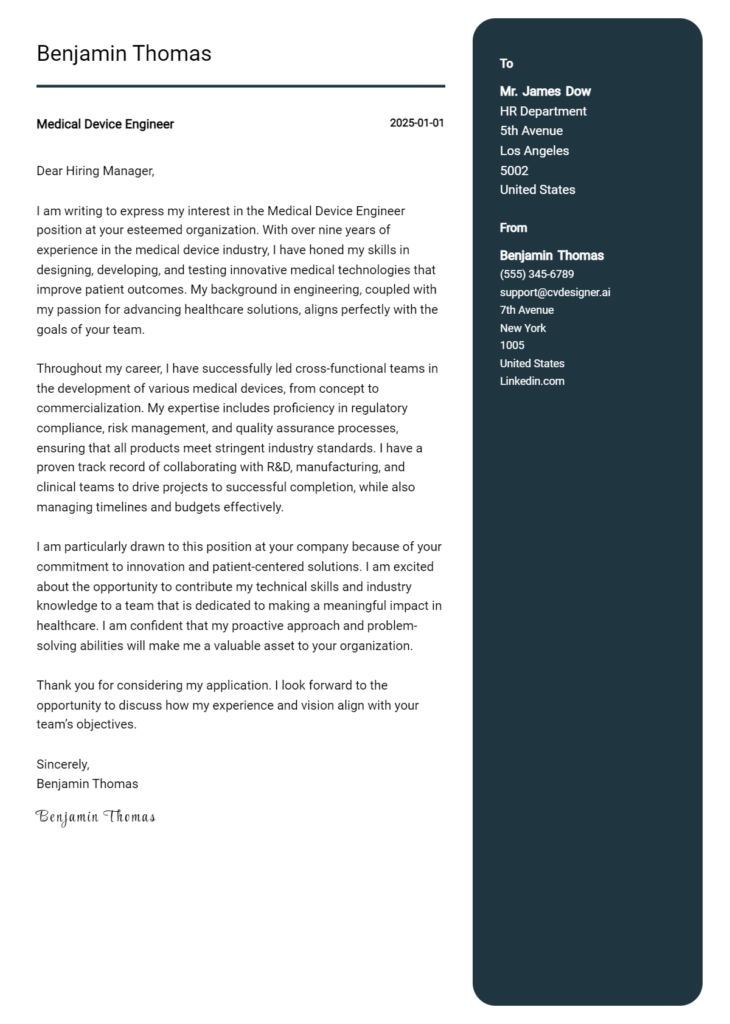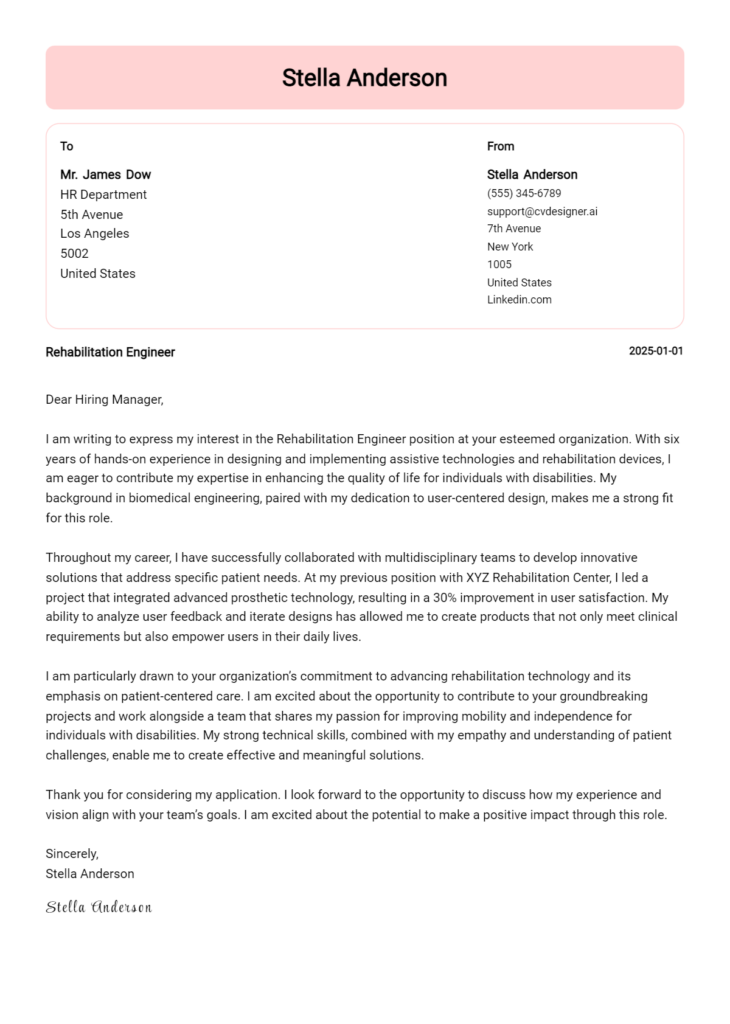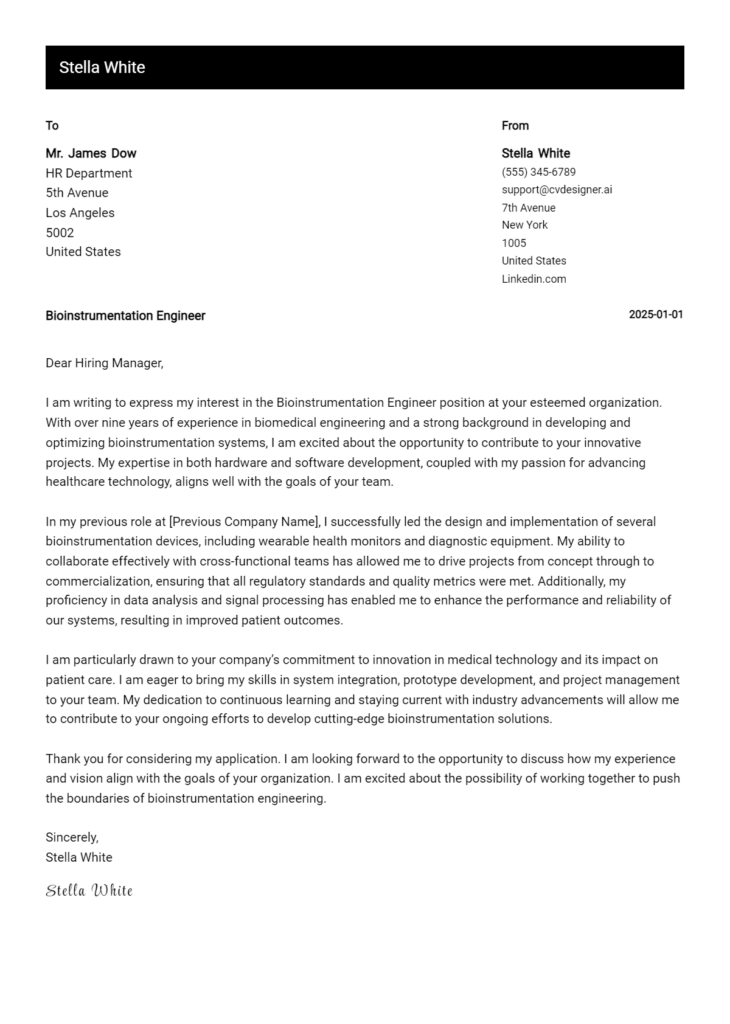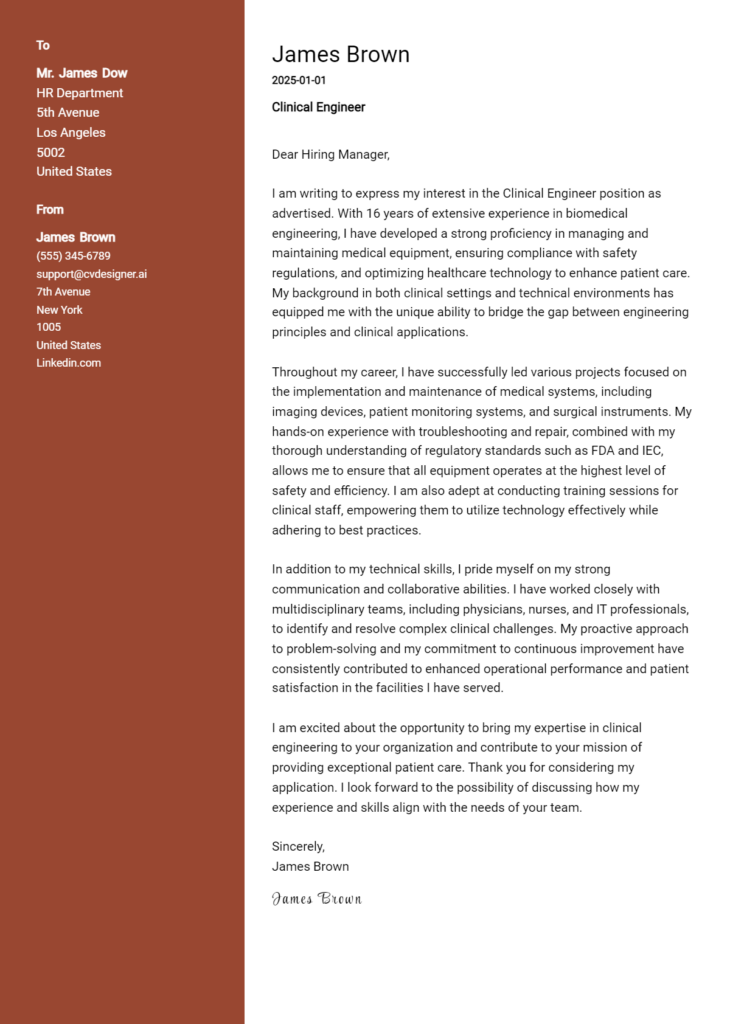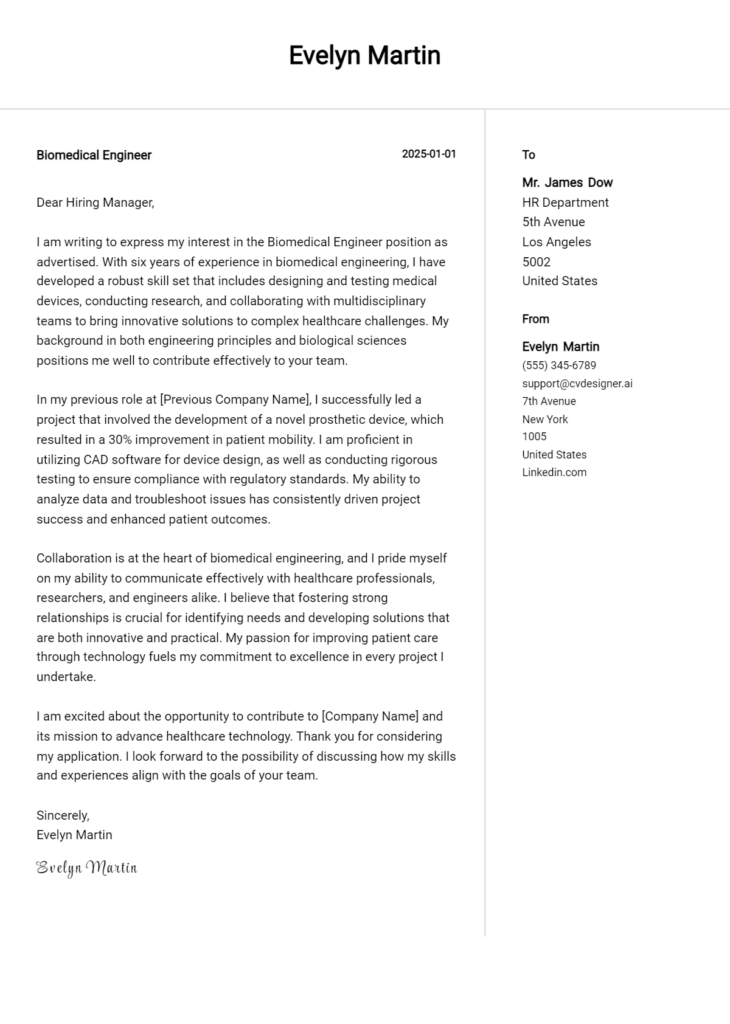Biomaterials Engineer 2 Cover Letter Examples
Explore additional Biomaterials Engineer 2 cover letter samples and guides and see what works for your level of experience or role.
How to Format a Biomaterials Engineer Cover Letter
Crafting an effective cover letter as a Biomaterials Engineer is essential, as it serves as your first opportunity to make a strong impression on potential employers. The way you format your cover letter conveys your technical expertise and innovative thinking—crucial attributes in the field of biomaterials. A well-structured cover letter not only captures the hiring manager's attention but also demonstrates your ability to communicate complex ideas clearly and concisely.
In this guide, we'll explore how to organize your cover letter, providing valuable insights and examples tailored for aspiring biomaterials engineers.
We will focus on the key components of a professional cover letter, including:
- Cover Letter Header
- Cover Letter Greeting
- Cover Letter Introduction
- Cover Letter Body
- Cover Letter Closing
Each section plays a crucial role in showcasing your qualifications, enthusiasm, and professionalism. Let’s delve into each part and learn how to craft a standout cover letter for your biomaterials engineering career.
Importance of the Cover Letter Header for a Biomaterials Engineer
The cover letter header is a crucial component of your job application as a Biomaterials Engineer, as it sets the tone for your professionalism and attention to detail. A well-structured header provides clear contact information, ensuring that the hiring manager can easily reach you. It should include your name, address, phone number, email, the date, and the recipient's details (including their name, title, company name, and address). Clarity in your header reflects your organizational skills and enhances your credibility, making it easier for potential employers to connect your application with your qualifications.
Here are examples of a strong and a weak cover letter header for a Biomaterials Engineer:
Strong Example
John Doe 1234 Innovation Drive Biomaterials City, BC 12345 (555) 123-4567 johndoe@email.com October 5, 2023 Dr. Jane Smith Hiring Manager Biomaterials Solutions Inc. 5678 Research Lane Biomaterials City, BC 12345
Weak Example
John 1234 Innovation Dr 10/5/23 To Whom It May Concern
Importance of the Cover Letter Greeting for a Biomaterials Engineer
The greeting of your cover letter is crucial as it sets the tone for the entire document. A well-crafted greeting not only demonstrates professionalism but also adds a personal touch by addressing the hiring manager directly. This personalized approach shows that you have taken the time to research and understand the company culture, which can differentiate you from other candidates. To avoid generic greetings that can come off as insincere, it is essential to make an effort to find the recipient's name. This can often be done through the company's website, LinkedIn, or by calling the company directly. A strong greeting can create a positive first impression, while a weak one can undermine the quality of the rest of your cover letter.
Strong Greeting Example
Dear Dr. Smith,
Weak Greeting Example
To Whom It May Concern,
The Importance of a Well-Crafted Cover Letter Introduction for a Biomaterials Engineer
A well-crafted cover letter introduction is crucial for a Biomaterials Engineer, as it serves as the first impression a candidate makes on the hiring manager. This introduction must effectively capture attention, articulate the candidate's enthusiasm for the role, and succinctly highlight relevant skills or accomplishments that align with the job requirements. A strong opening can set the tone for the entire application, making it memorable and compelling, while a weak introduction may fail to engage the reader, causing a missed opportunity to showcase the candidate’s potential. Below are examples of strong and weak cover letter introductions for the role of a Biomaterials Engineer.
Strong Example
Dear [Hiring Manager's Name], As a passionate Biomaterials Engineer with over five years of experience in developing innovative materials for medical applications, I am excited to apply for the position at [Company Name]. My recent project on biodegradable polymers not only improved patient outcomes but also significantly reduced environmental impact, aligning with your company's commitment to sustainability. I am eager to bring my expertise in biomaterial design and research to your talented team and contribute to pioneering advancements in healthcare.
Weak Example
Hello, I am writing to apply for the Biomaterials Engineer position. I have a degree in biomaterials and have worked in various roles. I think I can do this job well. Thank you for considering my application.
Purpose of the Cover Letter Body for a Biomaterials Engineer
The cover letter body for a Biomaterials Engineer serves as a critical component in showcasing the candidate's unique skills, relevant experiences, and overall value to the prospective employer. This section allows the candidate to highlight specific projects or accomplishments that demonstrate their expertise in biomaterials, such as developing innovative materials for drug delivery systems or contributing to research that improved biocompatibility in medical devices. By detailing these experiences, the candidate can effectively illustrate their technical capabilities and problem-solving skills, which are essential for success in this field. It also provides an opportunity to connect past experiences with the company's goals, thus reinforcing the candidate's fit for the role.
Strong Example
During my tenure at XYZ Biotech, I led a project focused on the development of a novel biodegradable polymer for use in stents, which resulted in a 30% increase in biocompatibility compared to existing options. This project not only enhanced my technical skills in polymer synthesis and characterization but also honed my ability to collaborate with cross-functional teams, ensuring timely project completion and alignment with regulatory standards. My contributions were recognized with the 'Innovative Research Award' at our annual company conference, further solidifying my commitment to advancing biomaterials technology.
Weak Example
I have worked with biomaterials in the past. I think I would be a good fit for your company. I am familiar with some projects, but I haven’t really led any. I am interested in learning more about biomaterials engineering and hope to contribute to your team.
Importance of the Cover Letter Closing for a Biomaterials Engineer
The closing paragraph of a cover letter is crucial as it serves to summarize your qualifications, reinforce your enthusiasm for the position, and encourage the hiring manager to take the next steps, such as reviewing your resume or scheduling an interview. A strong closing leaves a lasting impression and highlights your suitability for the role, while a weak closing may fail to entice the reader to consider you further.
Strong Example
Thank you for considering my application for the Biomaterials Engineer position. With a robust background in biomaterials research and a passion for innovative solutions in healthcare, I am excited about the opportunity to contribute to your team. I look forward to discussing how my skills in material development and testing can align with your organization’s goals. Please feel free to contact me to arrange an interview at your earliest convenience.
Weak Example
I hope you like my application. I think I would be a good fit for the Biomaterials Engineer role. Let me know if you're interested.
Crafting an effective cover letter for a Biomaterials Engineer position is crucial in making a strong first impression on potential employers. A well-written cover letter allows candidates to showcase their technical skills, problem-solving abilities, knowledge of the software development life cycle (SDLC), teamwork experience, and their passion for continuous learning. Below are some detailed tips to help you create a compelling cover letter that highlights your qualifications and sets you apart from other applicants.
Cover Letter Writing Tips for Biomaterials Engineer
Highlight Technical Skills: Clearly outline your technical skills relevant to biomaterials engineering. Mention specific materials, processes, or technologies you have experience with, such as biocompatible materials, polymer science, or tissue engineering. Be sure to back up your claims with concrete examples from previous projects or work experiences. This will demonstrate your expertise and readiness to tackle the challenges of the role.
Showcase Problem-Solving Abilities: Employers value candidates who can think critically and solve complex problems. Use your cover letter to describe a specific challenge you faced in a previous role and how you approached it. Detail your thought process, the steps you took to address the issue, and the successful outcome. This not only showcases your problem-solving skills but also your ability to apply them in real-world scenarios.
Demonstrate Knowledge of SDLC: If you have experience working within the software development life cycle, be sure to mention it. Describe how your understanding of SDLC principles has influenced your work in biomaterials engineering. Whether it’s through project management, design, or testing, showing familiarity with SDLC can make you a more attractive candidate, especially in interdisciplinary roles that involve software and materials engineering.
Emphasize Teamwork and Collaboration: Biomaterials engineering often involves working in multidisciplinary teams. Highlight your experience collaborating with professionals from various backgrounds, such as biomedical engineers, chemists, and medical professionals. Provide examples of how you contributed to the team's success and how effective communication and collaboration were vital in achieving project goals.
Convey a Passion for Continuous Learning: The field of biomaterials is ever-evolving, so demonstrating a commitment to continuous learning is essential. Mention any relevant courses, certifications, or workshops you have completed or are currently pursuing. This shows employers that you are proactive about staying updated with industry trends and advancements, which can be a significant asset to their team.
By following these tips, you can create a strong cover letter that effectively highlights your qualifications as a Biomaterials Engineer. For additional resources, consider using cover letter templates or a cover letter builder to streamline your writing process.
Common Mistakes to Avoid in a Biomaterials Engineer Cover Letter
Crafting a compelling cover letter is essential for standing out in the competitive field of biomaterials engineering. Avoiding common mistakes can significantly enhance your chances of making a positive impression. Here are some frequent missteps to steer clear of:
Generic Greetings: Using "To Whom It May Concern" can signal a lack of effort. Instead, research the hiring manager’s name to personalize your greeting.
Repetition of the Resume: Simply restating your resume does not add value. Use your cover letter to highlight specific achievements and how they relate to the position.
Lack of Focus on the Employer: Failing to address the company’s goals or projects can make your letter seem self-centered. Show how your skills align with their needs and future endeavors.
Ignoring Formatting Guidelines: Not adhering to a professional cover letter format can detract from your presentation. Familiarize yourself with proper cover letter format to maintain professionalism.
Poor Spelling and Grammar: Typos and grammatical errors can undermine your credibility. Always proofread your letter and consider asking someone else to review it.
Being Overly Technical: While technical knowledge is crucial for a biomaterials engineer, overly complex jargon can alienate your reader. Aim for clarity and conciseness.
Neglecting to Tailor Your Letter: Sending a one-size-fits-all cover letter can be detrimental. Customize each letter to reflect the specific role and company, using relevant cover letter examples for inspiration.
By avoiding these pitfalls, you can create a cover letter that effectively communicates your strengths and enhances your candidacy in the biomaterials engineering field.
Cover Letter FAQs for Biomaterials Engineer
What should I include in my cover letter for a Biomaterials Engineer position?
In your cover letter, start with a strong introduction that highlights your interest in the position and the company. Include specific experiences and skills relevant to the biomaterials field, such as your knowledge of polymer science or experience with tissue engineering. Discuss any relevant projects or research work, emphasizing your problem-solving abilities and innovative approaches. Don't forget to mention any collaborations with interdisciplinary teams or experience in regulatory compliance, which are crucial in biomaterials engineering. Finally, conclude by expressing your enthusiasm for the role and how you envision contributing to the organization’s goals.
How can I demonstrate my technical skills in my cover letter?
To effectively demonstrate your technical skills in your cover letter, provide concrete examples of projects or tasks where you applied these skills. Mention specific biomaterials you’ve worked with, such as biopolymers or ceramics, and describe the techniques you utilized, like 3D printing or surface modification. If relevant, highlight any software tools or modeling techniques you are proficient in, such as CAD software or molecular dynamics simulations. Use metrics to quantify your achievements, such as improvements in material properties or successful project outcomes, to give your claims more weight. This approach will help paint a clear picture of your capabilities to potential employers.
How can I tailor my cover letter to a specific job posting?
To tailor your cover letter, carefully analyze the job posting for keywords and specific skills that the employer is seeking. Match your experiences and qualifications with these requirements by incorporating the language and phrases used in the job description. If the role emphasizes teamwork, highlight instances where you successfully collaborated on biomaterials projects. If innovation is a theme, discuss any unique solutions you’ve developed. Additionally, research the company’s projects and values, and mention how your background aligns with their mission. This personalized approach shows that you’re genuinely interested in the position and have taken the time to understand the employer's needs.
What mistakes should I avoid in my cover letter for a Biomaterials Engineer role?
Common mistakes to avoid include generic language that fails to convey your unique qualifications and enthusiasm for the role. Steer clear of lengthy paragraphs; instead, use concise sentences for clarity. Avoid using jargon that may not be understood by all readers, especially if your cover letter will be reviewed by HR personnel. Additionally, ensure that your cover letter is free of typos and grammatical errors, as these can undermine your professionalism. Finally, don’t neglect to address the hiring manager by name, if possible, as this personal touch can set your application apart from others.
Build your Cover Letter in minutes
Use an AI-powered cover letter builder and have your letter done in 5 minutes. Just select your template and our software will guide you through the process.

